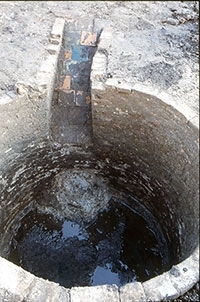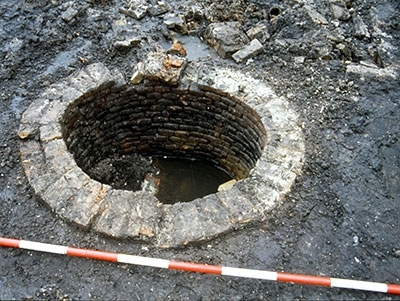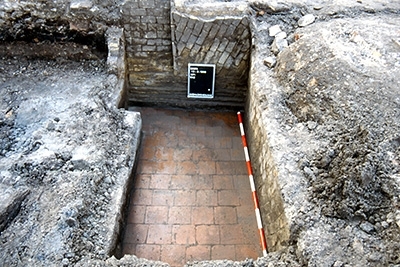Research project
Mapping pre-industrial sanitation infrastructure in the town of Haarlem
The central research question focuses on identifying shifts in the urban social network in terms of private, semi-public and public space by means of mapping the spatial distributions of wells and cesspits in the town of Haarlem in the course of the pre-industrial period (1200-1800). Shifts may be indicative of changes in social cohesion within the urban community.
- Duration
- 2014
- Contact
- Roos van Oosten
- Funding
-
 DANS Small Data Project / Kleine Data Projecten/KDP
DANS Small Data Project / Kleine Data Projecten/KDP
- Partners
R.H. (Rein) van 't Veer, MA, Bureau Digitaal Erfgoed
Identifying shifts in the urban social network by mapping and analyzing the spatial distributions of archaeologically uncovered wells and cesspits of the pre-industrial period in the town of Haarlem by means of a digital map application.
In this project, the term 'cesspit' refers to any structure that serves to collect human excrement (brick-built cesspits, unlined cesspits and privy vaults); the term ‘well’ here also covers pumps and cisterns.
Project description

Over the past three decades, excavations in towns throughout the Netherlands have uncovered hundreds of cesspits and dozens of wells. Although data are available in abundance, the data are well hidden in numerous different small projects. This rather fragmented state of affairs hinders any integrative overview. This project should lead to Identifying shifts in the urban social network in pre-industrial times.
Well communities
In pre-industrial towns, wells and cesspits were generally not held in private ownership. Wells were collectively managed by 'well communities'. Historical sources reveal that, for example, the town of Zutphen was subdivided into well communities each comprising about 25 households. Their members would ensure that the communal well was properly maintained (as a village pump would be). They were micro-communities which coincided with, or evolved into, urban wards. The increasing prevalence of private wells and underground cisterns in the 17th century suggests that the importance of the well communities declined.

A similar shift towards private space can be observed in the case of cesspits. In contrast to the public wells, cesspits were situated in the semi-private back yards. In the Late Medieval period they were in communal use by several households. From historical sources in Bruges we know that such shared facilities increasingly gave way to private cesspits (Deneweth 2008).
If the developments mentioned above reflect a broader cultural shift, they may be strong evidence of changes in social cohesion within the urban community. Or, put in more general terms, shifts in the private realm may manifest changes in the public realm. This argument features prominently in the research of historian Philip Ariès, and is denoted as 'one of the big themes of history' (Rowbotham 2005).

Data and methods
The data relating to cesspits and wells from Haarlem were assembled in a database as part of an earlier NWO-funded project. These data are to be complemented with geographical information, now that the present DANS Small Data Project (KDP) will analyse the spatialdistributions of wells and cesspits. The archaeological maps will be geo-referenced with open-source software (Q-GIS). The outcome will be a digital map application developed by means of semantic web technology.
Spin-off
This map application will be the basis for an analysis of the spatial aspects of sanitation management in a scholarly publication. In addition, the map application will be used at the Archaeological Museum of Haarlem as a feature in the exhibition Wells and cesspits from Haarlem's history. The exhibition is to open in the spring of 2015.
Relations with other projects
This is a spin-off of an NWO-funded project, The town as a body social. In the purview of this project the rise and decline of the cesspit phenomenon were analysed from a diachronic perspective and presented in a PhD thesis entitled The town, the waste and the cessipit (Van Oosten 2013). The present DANS Small Data Project (KDP) will now analyse the spatial distributions of wells and cesspits.
Literature
-
Benders, J. & D. de Boer, 2012: ‘Putten uit bronnen, bronnen uit putten. Sociale geschiedenis van de waterput en beerput in de Nederlanden tot het begin van de zeventiende eeuw’, in: E. Taverne, L. de Klerk, B. Ramakers & S. Dembski (eds), Nederland stedenland. Continuïteit en vernieuwing, Rotterdam, 150-164.
-
Deneweth, H., 2008: Huizen en mensen. Wonen, verbouwen, investeren en lenen in drie Brugse wijken van de late middeleeuwen tot de negentiende eeuw, Brussel (proefschrift Vrije Universiteit Brussel).
-
Oosten, R.M.R. van, 2013: De stad, het vuil en de beerput. Een archeologisch-historische studie naar de opkomst, verbreiding en neergang van de beerput in stedelijke context (13e tot 18e eeuw), Ph D thesis, University of Groningen, Groningen.
-
Rowbotham, S., 2005: ‘How does private life affect public life?’, in: H. Swain ed. Big questions in history, London, 221-228.
